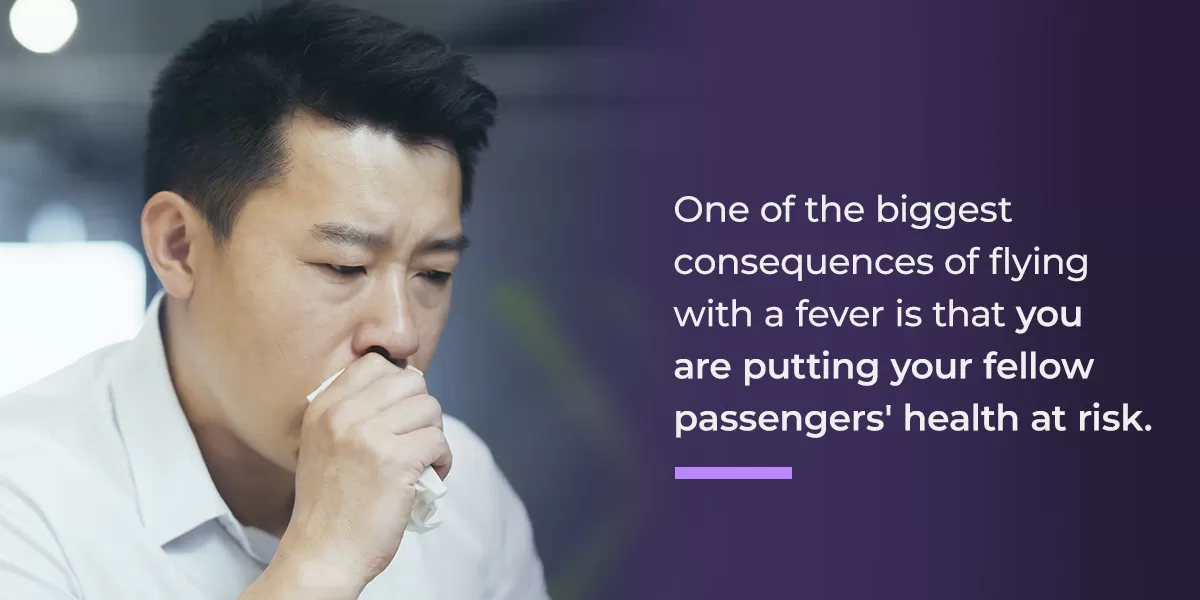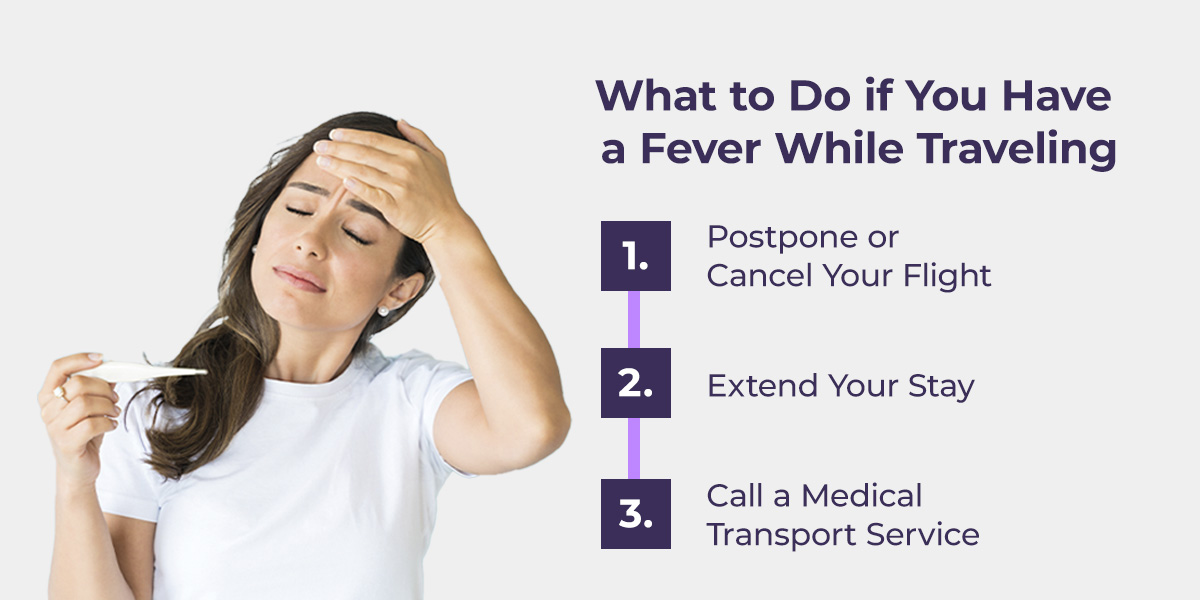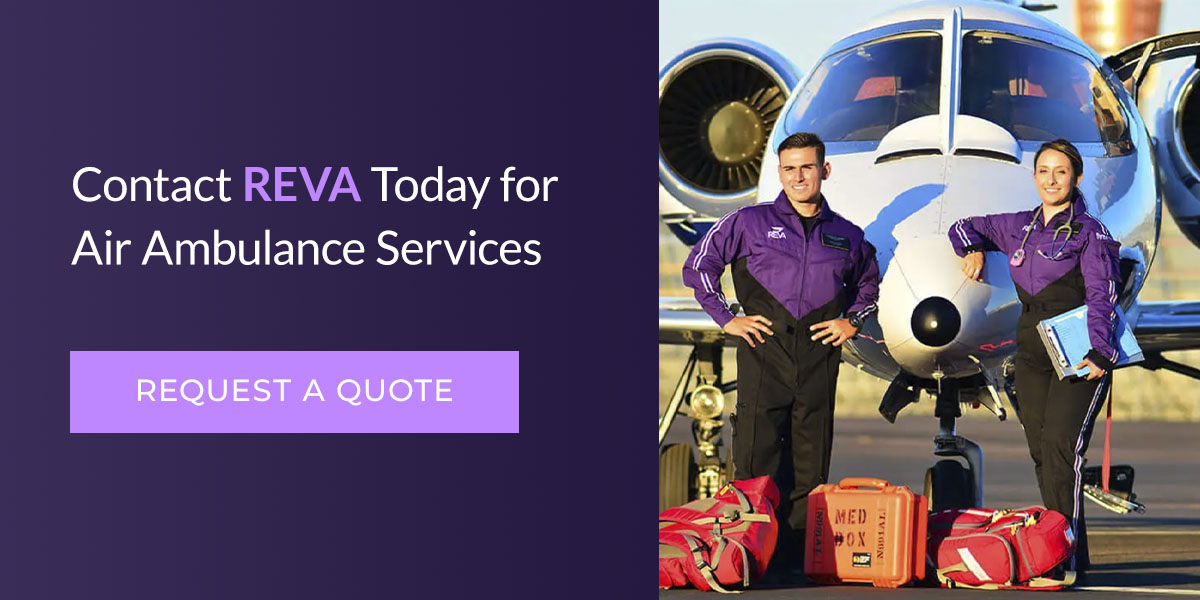Commercial flights are already stressful for most people. Long lines, invasive security checks and customs make the international travel experience trying for anyone — especially when you’re not feeling at your best. Ultimately, you have to decide whether you should fly with a fever or stay in bed.
If you find yourself sick while away from home, or your temperature spikes right before an upcoming trip, you need to put your body’s needs first to make a speedy recovery. Learn what happens if you fly with a fever and how to avoid the resulting health complications.
What Is a Fever?
A fever is a temporary rise in internal temperature as part of your body’s immune response to infectious diseases such as:
- Pneumonia
- Tuberculosis
- The common cold
- Urinary tract infections
- COVID-19
- Influenza
Usually, the body maintains an internal temperature of about 98.6 degrees Fahrenheit (37 degrees Celsius). Raising your core temperature makes it easier for your immune system to kill off harmful bacteria and viruses. The process usually follows these stages:
- Reaction: The brain signals the body to heat up. The blood vessels in your skin constrict and your muscles contract, causing you to shiver and feel cold even though your internal temperature is rising.
- Peak: Once you reach the point where your body is producing and giving off the same amount of heat, it remains at its new temperature to enhance the immune response.
- Cool down: Finally, your body returns to its normal temperature by opening the blood vessels in your skin and sweating. This phase can occur naturally, but you may need to take fever-relieving medications to decrease your temperature.
After the fever breaks, you’ll likely be dehydrated and feel warm. Drink plenty of fluids to replenish your body and continue to rest.
When Is a Fever Dangerous?
Although it’s a valuable tool for fighting off disease, a high internal temperature can cause serious damage. Fevers occur at different levels of severity:
- Low-grade: 99.1 to 100.4 degrees Fahrenheit, or 37.3 to 38 degrees Celsius
- Moderate-grade: 100.6 to 102.2 degrees Fahrenheit, or 38.1 to 39 degrees Celsius
- High-grade: 102.4 to 105.8 degrees Fahrenheit, or 39.1 to 41 degrees Celsius
Seek medical treatment if your temperature exceeds 104 degrees Fahrenheit. Left untreated, a high-grade fever can have dangerous complications such as seizures, brain damage and even death. If you are experiencing temperatures above 102.4 degrees Fahrenheit, or your fever does not break with rest and/or medicine, call a doctor.
What do you do when you’re traveling and you need treatment? Flying home in commercial aircraft can be risky when you have a fever, especially when your temperature is exceedingly high. Arranging emergency transport with an air ambulance provider may be necessary in these situations.
What Are the Risks of Flying With a Fever?
A mild fever may not seem like a medical emergency, but treating it too lightly can have serious consequences for your health.
1. Increased Risk of Thrombosis
When you’re on a long flight, you’re immobile for hours on end, and you’re likely not drinking much fluid. This lack of activity and dehydration causes the blood to thicken, increasing the risk of developing a thrombosis.
A thrombus is a blood clot that forms in a blood vessel, usually in the lower legs. When it lodges in place and slows or blocks blood flow, it’s called a thrombosis. If the thrombus gets free and travels to your vital organs, such as your heart or brain, it could lead to an embolism — a life-threatening condition that can cause permanent organ damage, stroke and death.
You’re at an even higher risk of thrombosis if your fever is the result of an infection, as inflammation caused by your body’s immune response can further restrict blood flow.
2. Making Your Illness Worse
It’s important to remember that a fever is a symptom of an illness, not a disease itself. Your immune system needs proper rest to function properly and fight that illness — and commercial air travel is far from a restful experience for most people.
You wait in long queues to get through security, carry heavy luggage through the airport and touch many high-traffic surfaces that house germs from thousands of other travelers. Exposing yourself to all these stressors interferes with your immune system’s function, which is already working harder than usual to fight off the illness.
Changes in air pressure during your flight can also make your condition worse. This is especially dangerous for cases of pneumonia, which causes your lungs to fill with fluid and impacts your ability to absorb oxygen into the bloodstream. Low air pressure in the cabin further compounds this issue, causing your blood oxygen saturation level to drop to critical levels.
Ultimately, it’s better to give your body some time to rest and recover before traveling anywhere, especially if you don’t know what illness is causing the fever. You will get better faster and reduce the risk of your condition turning into something more dangerous.
3. Potential to Infect Others
One of the biggest consequences of flying with a fever is that you are putting your fellow passengers’ health at risk. As mentioned, fevers are usually symptoms of infectious diseases, which are typically contagious. If you have a fever and returning from a different country, you may have contracted a disease you wouldn’t necessarily be at risk of contracting at home. Seeking medical attention for your fever before getting on a flight home is essential to protect yourself and others.
When you’re sitting close to others for long stretches of time, you’re likely to spread your illness to them, especially if you begin coughing or sneezing. Plus, high-touch airport surfaces have thousands of microorganisms on them. Exposure to the germs on those surfaces can make you sicker, and the germs you leave behind could also expose someone else to your illness.
Can You Get on a Plane With a Fever?
While you can fly with a slightly elevated temperature, you should generally avoid flying if you have a fever of 100.4 degrees Fahrenheit or higher. It’s also possible that you may not be allowed to fly with a fever. Every commercial airline has the right to deny a passenger entry onto a flight in accordance with specific guidelines and laws, and sickness can be a reason.
Ground personnel and crew watch for passengers with obvious signs of illness, such as:
- Difficulty breathing
- Noticeable weakness
- Confusion
- Sweating
- Trembling
- Decreased consciousness
Before traveling to a different country, it can be beneficial to check the Centers for Disease Control and Prevention’s database of global destinations. Locate your travel destination and read about any current travel notices or precautions. This way, you can take steps to prevent getting sick on your trip, and you’ll know what to do if you come down with a fever and need to fly.
What to Do if You Have a Fever While Traveling
It’s not safe to fly with a fever, which is why it’s important to know what to do if you get sick before your flight. Here are some of the actions you can take if illness suddenly requires you to change your plans:
1. Postpone or Cancel Your Flight
Each airline has a different policy regarding cancellations and refunds, so be sure to check before you reach out so you know what to expect.
To cancel your flight, contact the airline or travel agency you purchased your tickets from and go through their customer service process. If you have a changeable ticket, you may want to reschedule your trip instead. Postponing your flight can cost you a fee depending on the airline and destination, but you may only have to pay the difference in ticket prices.
2. Extend Your Stay
Flying with a fever is still a bad idea if you get sick during your trip. Fortunately, a day or two of rest and some over-the-counter medicine can often make a big difference. Take care of your flight arrangements, then try to extend your stay for a few days to focus on recovery.
If your symptoms escalate, seek emergency medical treatment immediately. Emergency medical transport through an air ambulance service can return you to your home country so you can ensure you receive the care you need.
3. Call a Medical Transport Service
If you’re in a remote area without access to quality care, or you need emergency treatment, it may be your safest choice to call an air ambulance for medical repatriation.
The benefits of using an air ambulance service when you have a fever include:
- Experienced crew: A team of qualified medical professionals will be with you throughout your journey to provide proper treatment.
- Reduced thrombosis risk: Your medical team will take the proper measures to prevent thrombosis while allowing you to lay back and rest.
- Safety: A reliable air ambulance service like REVA always has your safety top of mind. If flying at altitude would cause the air pressure to become too low, the aircraft can remain at sea level for the duration of the flight.
- Minimal risk of infection: The only people in an air ambulance with you are your medical team and any loved ones you may have with you, so there’s no risk of spreading your illness to other travelers.
An air ambulance service like REVA can ensure you have access to the care you need without putting your health at risk.
What Does an Air Ambulance Cost?
Because air ambulance costs are determined on a case-by-case basis, specific costs are difficult to provide. The factors that go into determining air ambulance costs include:
- Your flight route
- The severity of your condition
- The level of urgency
- Travel companions
- Special considerations
If you have travel medical insurance, your policy may cover the cost of your flight. Most travel insurance providers only cover medically necessary cases, such as emergencies and situations where suitable treatment isn’t locally available.
Some providers also cover medically reasonable cases, which includes any situation where returning to your country is more likely to give you higher quality care. Check your plan or contact your insurance provider to confirm coverage details.
Tips for Traveling With a Fever
Traveling isn’t cheap, and making last-minute changes to your plans often comes with additional fees and restrictions. Regardless, you want to do what you can to avoid flying with a fever.
Contact the Airline as Early as Possible
It’s always best to be on the safe side. As soon as you think you might be unfit to fly, get a doctor’s note or another medical document proving your illness. Airline policies regarding rebooking fees can vary wildly between companies, and having documentation ready is usually the best step you can take to avoid getting charged.
That said, it’s still worth a try if your circumstances make it impossible to see a doctor. Some airlines have less strict cancellation policies than others, so you may be able to get at least a partial travel credit if you reach out before your scheduled departure.
Purchase Travel Insurance
It’s always best to be prepared in case of an emergency. Investing in travel medical insurance can protect you from having to pay for care out of pocket when you’re traveling anywhere outside your primary insurer’s network.
You have two main options when you’re shopping for travel insurance — a standalone plan that only covers medical emergencies, or a comprehensive plan that includes other unexpected travel situations.
A typical comprehensive travel insurance policy covers medical emergencies and other unforeseen costs, such as:
- Trip cancellations
- Trip interruptions or delays
- Vacation rentals
- Rental car coverage
- Lost luggage
You may also want to consider investing in a Cancel For Any Reason (CFAR) policy add-on. Unlike standard trip cancellation insurance, which comes included with most comprehensive travel insurance policies, the CFAR benefit is completely optional and will kick in if you need to cancel your flight for any reason — even those not covered by your plan. A CFAR benefit typically reimburses you 50% to 75% of any prepaid and nonrefundable costs, though the exact amount will vary based on the policy.
Contact REVA Today for Air Ambulance Services
Have you or a traveling partner come down with a fever during your trip? A REVA air ambulance can bring you home so you can get the care you need.
Our experienced flight and medical crews deliver high-quality care on both domestic and international flights, and we require ongoing training to ensure consistency and excellence. When you request a flight from us, we manage the whole process and accept all major insurance providers, so you can rest easy knowing you’re in good hands.
Request a free online quote for our air ambulance services today.




